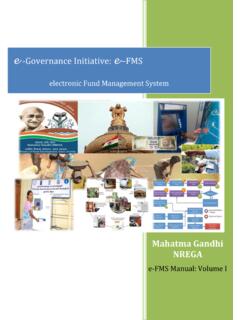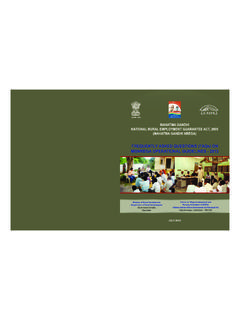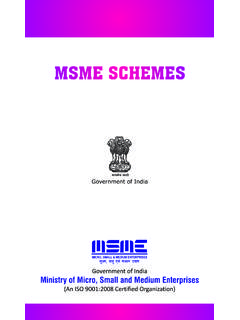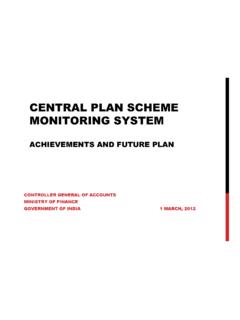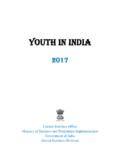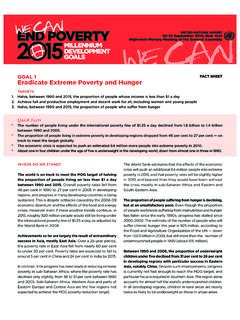Transcription of FAO Technical Guide 2
1 A Toolkit on gender-sensitive social protection programmes to combat rural poverty and hungerFAO Technical Guide 2 Integrating gender into the design of cash transfer and public works programmes Food and Agriculture Organization of the United Nations (FAO)Rome, 2018 FAO Technical Guide 2 Integrating gender into the design of cash transfer and public works programmes A Toolkit on gender-sensitive social protection programmes to combat rural poverty and hungerThe designations employed and the presentation of material in this information product do not imply the expression of any opinion whatsoever on the part of the Food and Agriculture Organization of the United Nations (FAO) concerning the legal or development status of any country, territory, city or area or of its authorities, or concerning the delimitation of its frontiers or boundaries.
2 The mention of specific companies or products of manufacturers, whether or not these have been patented, does not imply that these have been endorsed or recommended by FAO in preference to others of a similar nature that are not views expressed in this information product are those of the author(s) and do not necessarily reflect the views or policies of FAO. ISBN 978-92-5-131039-7 FAO, 2018 Some rights reserved. This work is made available under the Creative Commons Attribution-NonCommercial-ShareAlike IGO licence (CC BY-NC-SA IGO; ).Under the terms of this licence, this work may be copied, redistributed and adapted for non-commercial purposes, provided that the work is appropriately cited. In any use of this work, there should be no suggestion that FAO endorses any specific organization, products or services.
3 The use of the FAO logo is not permitted. If the work is adapted, then it must be licensed under the same or equivalent Creative Commons license. If a translation of this work is created, it must include the following disclaimer along with the required citation: This translation was not created by the Food and Agriculture Organization of the United Nations (FAO). FAO is not responsible for the content or accuracy of this translation. The original English edition shall be the authoritative mediation relating to disputes arising under the licence shall be conducted in accordance with the Arbitration Rules of the United NationsCommission on International Trade Law (UNCITRAL) as at present in materials. Users wishing to reuse material from this work that is attributed to a third party, such as tables, figures or images, are responsible for determining whether permission is needed for that reuse and for obtaining permission from the copyright holder.
4 The risk of claims resulting from infringement of any third-party-owned component in the work rests solely with the , rights and licensing. FAO information products are available on the FAO website ( ) and can be purchased through Requests for commercial use should be submitted via: Queries regarding rights and licensing should be submitted to: citation:FAO. 2018. FAO Technical Guide 2 Integrating gender into the design of cash transfer and public works programmes. Rome. 88 : CC BY-NC-SA ContentsAcknowledgements ..vAbbreviations and acronyms ..viiIntroduction ..1 PART 1 A Guide to undertaking a gender-sensitive poverty and vulnerability analysis (GSPVA) .. Purpose and objectives of the GSPVA .. Key elements of the GSPVA .. Main steps in implementing the GSPVA ..14 PART 2 How to integrate gender considerations into the design of cash transfers.
5 Overview .. Programme objectives .. Targeting of beneficiaries .. Transfer size and payment predictability .. Programme conditions ..35 PART 3 How to integrate gender considerations into the design of Public Works Programme (PWPs) .. Overview .. Targeting of beneficiaries .. Type of transfer .. Working Selection of assets and the type of work ..47 PART 4 Enhancing impacts of social transfers through complementary support ..51 Overview ..52ivANNEX 1 Checklist for undertaking the GSPVA ..59 ANNEX 2 Targeting methods and their gender implications ..66 ANNEX 3 Checklist for ensuring gender-sensitivity of cash transfers ..68 ANNEX 4 Checklist for ensuring gender-sensitivity of PWPs ..70 ANNEX 5 Learning tools ..72 ANNEX 6 Key resources ..75 References ..77vAcknowledgementsThis document is the result of a joint effort of the Gender and Social Protection teams of the Social Policies and rural Institutions Division (ESP) of the Food and Agriculture Organization of the United Nations (FAO) prepared by Maja Gavrilovic, Juan Gonzalo Jaramillo Mejia, Susan Kaaria and Natalia Winder-Rossi, with Technical guidance from Ana Paula de la O Campos and Pamela authors are grateful to Liz Koechlein of FAO, Rebecca Holmes of the Overseas Development Institute (ODI), Professor Maxine Molyneux of the UCL Institute of the Americas, Amber Peterman of the United Nations Children s Fund (UNICEF), and Raquel Tebaldi of the International Policy Centre for Inclusive Growth (IPC-IG)
6 For having provided very useful feedback on draft versions of this document. Finally, the authors would like to thank Andrea W hr who developed the graphic design, Christine Legault and Chiara Villani of FAO who managed the publishing process and Gordon Ramsey for copyediting the and acronyms 4Ps Pantawid Pamilyang Pilipino Programme (Philippines)CCT Conditional Cash TransferCTP Cash Transfer ProgrammesCEDAW Convention on All Forms of Discrimination against WomenFAO Food and Agriculture Organization of the United NationsGSPVA Gender-sensitive poverty and vulnerability analysisIDS Institute of Development StudiesILO International Labour OrganizationIPC-IG International Policy Centre for Inclusive GrowthMGNREGS Mahatma Gandhi National rural Employment Guarantee Scheme (India)ODI Overseas Development InstitutePSNP Productive Safety Net Programme (Ethiopia)
7 PWP Public Works ProgrammeSP Social protectionVUP Vision 2020 Umurenge Programme (Rwanda)UNICEF United Nations Children s Fund1 IntroductionWelcome to FAO Technical Guide 2 Integrating gender into the design of cash transfer and public works programmes. This is the second of three Technical guides in the Toolkit on gender-sensitive social protection programmes to combat rural poverty and hunger (see Figure 1). Figure 1: Overview of Technical guides and key issues coveredThe purpose of the ToolkitThis Toolkit on gender-sensitive social protection programmes to combat rural poverty and hunger is designed to support social protection (SP) practitioners in their efforts to systematically apply a gender lens to SP programmes in ways that are in line with FAO commitments1 to expanding inclusive SP systems for rural populations.
8 The Toolkit is intended to deepen the knowledge and Technical skills practitioners require to integrate gender issues effectively into the design, delivery, and monitoring and evaluation of cash transfers and public works programmes (PWPs). The Toolkit has a specific focus on SP s role in reducing 1 Consult the FAO Social Protection Framework (FAO, 2017) for the Organization s corporate approach and programmatic work in Themes coveredTechnical Guide 1: Introduction to gender-sensitive SP programming. Why gender-sensitive approach to social protection matters? How gender inequalities affect rural women s vulnerability to poverty and crises? How social protection programmes impact gender equality and rural women s empowerment? Key dimensions of gender-sensitive approach to social Guide 2: Gender-sensitive design of cash transfers and PWPs.
9 Guidance for undertaking a gender-sensitive poverty and vulnerability analysis How to integrate gender into core features of cash transfers? How to integrate gender into core features of public works programmes Linking social transfers with gender-sensitive complementary interventionsTechnical Guide 3: Gender-sensitive programme implementation and M&E. Why gender-sensitive implementation matters? Key dimensions of gender-sensitive programme implementation The role of gender-sensitive M&E and learning systems How to develop a gender-sensitive M&E framework?2 Toolkit on gender-sensitive social protection programmes to combat rural poverty and hungergender inequalities and rural poverty and hunger. For a detailed discussion of the rationale and scope of the Toolkit, see Technical Guide 1. The Toolkit is designed for government staff involved in SP programme development and implementation.
10 It may also be of use to FAO gender and social protection focal points in regional and country offices, development partners and SP practitioners in general. Overview of Technical Guide 2 Technical Guide 2, which provides practical advice on how to formulate and design a gender-sensitive cash transfer and PWP, has four parts: uPart 1: A Guide to undertaking a gender-sensitive poverty and vulnerability analysis (GSPVA). uPart 2: How to integrate gender considerations into the core design features of cash transfers. uPart 3: How to integrate gender considerations into the core design features of PWPs. uPart 4: Enhancing gender impacts of social transfers through complementary Guide 2 combines conceptual and empirical insights, illustrative examples, and practical tools, such as checklists and exercises (see Annexes 1-5).










